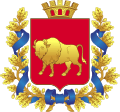Navahrudak
Navahrudak (Belarusian: Навагрудак, Navahrudak, Russian: Новогрудок, Novogrudok; Polish: Nowogródek; Lithuanian: Naugardukas) is a city in the Grodno Region of Belarus.
Navahrudak Навагрудак | |
|---|---|
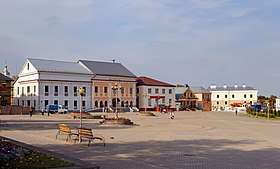 .jpg)   
| |
 Flag 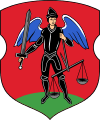 Coat of arms | |
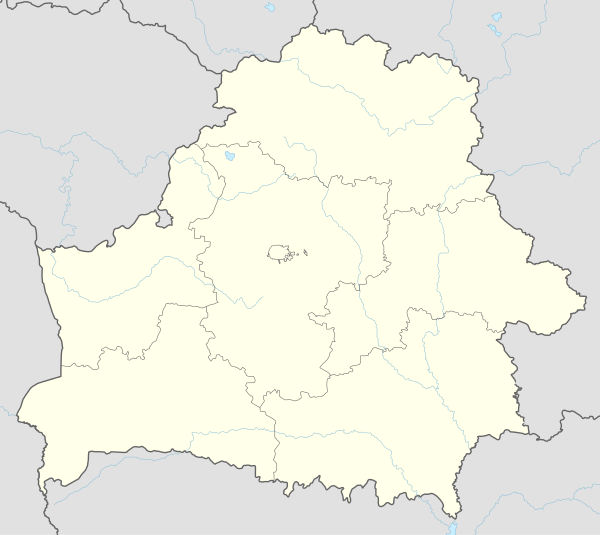 Navahrudak Navahrudak within the Grodno Region | |
| Coordinates: 53°35′N 25°49′E | |
| Country | |
| Region | Grodno |
| District (Rayon) | Navahrudak |
| Founded | 970 — 990 |
| First mention | 1044 |
| Town rights | 1444 |
| Government | |
| • Chairman of the district Executive Committee | Fedchenko Sergey[1] |
| Area | |
| • Total | 13,17 km2 (508 sq mi) |
| Elevation | 292 m (958 ft) |
| Population (2018)[2] | |
| • Total | 29,441 |
| • Density | 22/km2 (58/sq mi) |
| Time zone | UTC+2 (EET) |
| • Summer (DST) | UTC+3 (EEST) |
| Postal code | 231241, 231243, 231244, 231246, 231400 |
| Area code(s) | +375 1597 |
| License plate | 4 |
| Website | Official website |
In the 14th century, it was an episcopal see of the Metropolitanate of Lithuania. It is a possible first capital of the Grand Duchy of Lithuania, but Kernavė is also noted as a possibility. It was later part of the Polish–Lithuanian Commonwealth, the Russian Empire and eventually Poland until the Soviet invasion of Poland in 1939 when the Soviet Union annexed the area to the Byelorussian SSR.
History
.jpg)
Early history
According to archaeological research conducted in Novogrudok in the 1960s, the settlement on the territory of modern Novogrudok arose at the end of the X century, and the fortifications by the middle of the XI century.[3] Research also suggests that a city already existed on this site in the IX—X centuries, which had trade links with Byzantium, the Near East, Western Europe and Scandinavia. Archaeologically Novogrudok was studied in the years 1957-1977. In the first half of the XI century, the city consisted of two undefended settlements located on the Small castle and on the Castle hill. In the second half of the XI century, fortifications were built around the settlement on the Castle hill, thus forming the Navahrudak detinets. On the Small Castle to the West of Detinets formed a settlement, which in the XII century was also fortified and turned into a roundabout city.
.jpg)
On the territory of detinets, wooden ground buildings with Adobe stoves and plank floors were studied. The most important activities of the city's population were crafts and trade. Especially often there is evidence of local jewelry craft — there were foundries and jewelry workshops that formed a whole block on the small castle.[4] Bone-cutting, wood and stone processing were also common. Graffiti with old Russian letters was found on fragments of frescoed plaster from building No.12 ("house of the boyar" or "powalush") of the XII century on the Small Castle (an ancient roundabout city).[5][6] Trade relations were extremely wide in the XII—XIII centuries, as evidenced by a huge number of imported products: from Kiev to Novogrudok came glass bracelets, jewelry made of non-ferrous metals, encolpions, icons, spindle whorls, from Iran — faience vessels, from Byzantium and Syria-glassware, from the Baltic — amber.[7]
Navahrudak was first mentioned in the Sophian First Chronicle and Fourth Novgorod Chronicle in 1044 in reference to a war between Yaroslav I the Wise and Lithuanian tribes.[8] It was also mentioned in the Hypatian Codex in 1252 as Novogorodok, meaning "new little town". Navahrudak was a major settlement in the remote western lands of the Krivichs that came under the control of the Kievan Rus at the end of the 10th century. This hypothesis has been disputed, however, as the earliest archaeological findings date from the 11th century.[9]
Grand Duchy of Lithuania
.jpg)
In the XIIIth century, the fragile unity of the Kievan Rus was disintegrated by the nomadic incursions from Asia, which reached a climax with the Mongol horde's Siege of Kiev (1240), resulting in the sacking of Kiev and leaving a geopolitical vacuum in the region, later referred to as Black Ruthenia. The Early East Slavs splintered along pre-existing tribal lines and formed a number of independent, competing principalities.

In the late 1240s and early 1250s, Duke Mindaugas, made use of the plight, came to power in Navahrudak, and his son Vaišvilkas became his deputy. At this time, the beginning of the formation of the Lithuania was laid, the first capital of which was Navahrudak[10][11][12][13][14][15] later the Grand Duchy of Lithuania.[16][17][18][19] During the 16th century, Maciej Stryjkowski was the first, in his chronicle,[20] to propose the theory that Navahrudak was the capital of the XIIIth-century state. Vaišvilkas, the son and successor of Mindaugas, took monastic vows in Lavrashev Monastery[21] near Novgorodok and founded an Orthodox convent there.[22] The enmity between Mindaugas and his relatives, who had found refuge in Volhynia, led to a great war with the Kingdom of Galicia–Volhynia, which made several major campaigns against the city, which forced Mindaugas to ally with the Livonian order. In 1253, Mindaugas was crowned king of Lithuania on behalf of the Pope. Voishelk made peace on behalf of his father with the Galician-Volyn Principality and handed over Navahrudak and all Lithuanian cities to Roman Danilovich.[23] After the break of the peace in 1258, Vaišvilkas again became a duke in Navahrudak, and then passed it along with the entire country to Shvarn. In 1314 the castle was besieged by the Teutonic Knights.[24] The city was repeatedly tried to capture the Tatars and their allies, and then the squads of the Galician-Volyn princes (1255, 1274, 1278) and the crusaders (1314, 1321, 1341, 1390, 1394 years).
.jpg)
As the center of the appanage Principality, Navahrudak was owned from 1329 by Prince Koriat, after 1358 by his son Fedor, and from 1386 by Kaributas.[25] Since 1392, Navahrudak is one of the centers of the Grand Ducal demesne of the Grand Duchy of Lithuania, where the stone Navahrudak Castle was built. At the end of the XIV — beginning of the XV century, Vytautas settled Lipka Tatars in Navahrudak and its surroundings. in 1428, he recorded the city along with the surrounding villages in the lifetime possession of his wife Uliana. In 1415, at the Council of Orthodox bishops in Navahrudak, Gregory Tsamblak was elected Metropolitan of the Grand Duchy of Lithuania. The Synod de facto declared autocephaly of the Orthodox Church in the Grand Duchy of Lithuania, and also reformed internal administration in the Church.[26] In 1422 in Navahrudak in the Transfiguration Church founded by Vytautas, the wedding of the king of Poland and the Grand Duke of Lithuania Jogaila with Sophia of Halshany took place.[27][28][29] This marriage gave rise to the Jagiellonian dynasty. After the Union of Krewo (1385) it was part of the Polish–Lithuanian Union, which became the Polish–Lithuanian Commonwealth after the Union of Lublin in 1569. It was the capital of the Nowogródek Voivodeship from 1507 until the Third Partition of Poland in 1795.[30]
Their son Casimir IV Jagiellon granted town rights in 1444.[30] In 1505, the Tatars try to capture the city, but failed. On July 26, 1511, it was granted Magdeburg rights by King Sigismund I the Old, which were confirmed in 1562, 1595 and 1776.[28][31] On March 18, 1595, King Sigismund III Vasa granted the city a coat of arms depicting Archangel Michael.[29] It was a royal city.[28] In 1568, there were 10 churches in the city.[32] After the Union of Brest, the Department of the Orthodox Metropolitan became a Uniate one. In the XVI century, Navahrudak was also one of the centers of the reformation. In 1597, king Sigismund III Vasa of the Polish-Lithuanian Commonwealth gave the townspeople of Navahrudak the privilege of 2 fairs a year for 2 weeks on the Catholic holidays Epiphany and Pentecost. From 1581 to 1775, the city hosted sessions of the Grand Duchy of Lithuania's Main Tribunal.
In September 1655, it was captured by the troops of Prince A. Trubetskoy in the war of the Tsardom of Russia with the Polish–Lithuanian Commonwealth. In 1661, the city was recaptured by the Polish-Lithuanian army, and was exempt from paying taxes for a period of 4 years. In the XVI-XVIII centuries, Navahrudak suffered several times from fires (1578, 1599, 1613, 1652, the most severe — in 1751, when 167 houses, 4 churches, the town hall and the office of the Governor burned down) and epidemics (1590, 1592, 1603, 1708). Military events and cataclysms that occurred in the XVII-XVIII centuries led the city to a strong decline. At the end of the XVIII century, there were 3 orthodox churches, 5 catholic churches, 6 monasteries, a synagogue, and a tatar mosque in Navahrudak.
During the Great Northern War in 1706, the city was occupied by Swedish troops, and later by Russian troops, who burned the city and blew up the castle. Great destruction was caused by a fire on may 1, 1751. On September 23, 1784, the king of Poland and Grand Duke of Lithuania Stanisław August Poniatowski arrived in the city. On his way back from Nesvizh, he visited the city, the ruins of the Navahrudak Castle, the tribunal and the city archive. During the war in defense of the Constitution on may 3, in early June 1792, Navahrudak was attacked by the 33,000-strong tsarist army under the command of Mikhail Krechetnikov. In mid-June 1792, after the defeat in the battle of Mir, Polish-Lithuanian troops under the command of Duke Louis of Württemberg retreated through Navahrudak to Grodno. Tatars from the corps of General Józef Bielak were among the last to leave the city. Earlier, they heroically defended the crossing of the Neman river from the tsarist troops in the Battle of Stolbtsy.
In the Russian Empire
.jpg)
In 1795, as a result of the third Partition of Polish–Lithuanian Commonwealth, it was annexed by Imperial Russia.[27] Administratively, it was part of the Slonim Governorate since 1796, and the Lithuania Governorate since 1801. It was transferred to the Minsk Governorate in 1843. The city is one of two possible birthplaces of Belarusian-Polish national poet Adam Mickiewicz. Mickiewicz was baptized in the local Transfiguration Church and spent his childhood in the city.[27]
.jpg)
During the Napoleonic Wars, after the occupation of Navahrudak by Napoleon's army, the 19th Dragoon regiment of the Lithuanian troops was formed from local residents. In 1817, the city had 428 wooden and 9 stone houses.[27] At that time, mainly Jews, Belarusians, Poles, Lipka Tatars and Russians lived in the city.[27] During the November Uprising, on July 22, 1831, Navahrudak was occupied for some time by the detachments of Y. Kashits and M. Mezheyevsky. After the liquidation of the Dominican school in 1834, the tsarist authorities opened a 5-class school, which turned into the Navahrudak gymnasium in 1858. In 1837, Navahrudak had 4 unpaved and 9 paved streets and alleys. During the January Uprising, an insurgent organization led by V. Borzobogaty was formed in the city. In 1863, priest Felician Lashkevich from Navahrudak took part in this uprising. As part of anti-Polish repressions after the January Uprising, the tsarist administration closed down the gymnasium as well as Catholic churches, which were transformed into Orthodox churches.[27]
In 1896, Rabbi Yosef-Yuzl Horowitz founded one of the most famous Jewish higher educational religious institutions in Navahrudak, the Novardok Yeshiva, which was one of the largest and most important yeshivas in pre-war Europe and a powerful force in the Musar movement. In 1905, the first gas street lamps appeared in Navahrudak. In 1910, there were 76 stone and 1074 wooden buildings in the city, and in 1914 there were 6 educational institutions in the city. In 1907-1909, a provincial branch of the Polish society "Enlightenment" worked in the city, which was engaged in supporting Polish education.[33] It had a thriving Jewish community. Its 1900 population was 5,015.[34]
During the First World War, the city was under German occupation from 22 September 1915 to 27 December 1918.[15] On September 22, 1915, Navahrudak was occupied by troops of the 10th German army. The Russian-German front was now only 20 km East of the city, along the Servechi river. The Germans built a power plant, a network of narrow-gauge railways, and telephone lines. The creation of polish and belarusian schools was also allowed in the city.
Mickiewicz's house was occupied by the German commander of the 17th reserve army corps, General of infantry Reinhold von Schaeffer-Boyadel. Due to the proximity of the front, Marshal Paul von Hindenburg came to Navahrudak. On December 27, 1918, the German army's cavalry left Navahrudak. In the evening, the Bolsheviks entered the city, greeted with an ovation by part of the Jewish and Russian population. Soon some Polish activists were arrested, and in March 1919 the Bolsheviks killed some of them in the ruins of the castle.
- Old views of Navahrudak
.jpg) Panorama. Józef Peszka, about 1800.
Panorama. Józef Peszka, about 1800..jpg) Castle mountain. A. Ales, 1835.
Castle mountain. A. Ales, 1835..jpg) Navahrudak town hall, plan in the XIX century.
Navahrudak town hall, plan in the XIX century..jpg) Castle Church before demolition by the tsarist authorities.
Castle Church before demolition by the tsarist authorities..jpg) Church of Boris and Gleb, Chair of the Lithuanian Orthodox Archdiocese Vincent Dmachoŭski, 1856[35].
Church of Boris and Gleb, Chair of the Lithuanian Orthodox Archdiocese Vincent Dmachoŭski, 1856[35]..jpg)
.jpg) Castle. Vincent Dmachoŭski, 1856.
Castle. Vincent Dmachoŭski, 1856..jpg) The corner of Market square and the streets of Slonim. Church of the Dominicans.
The corner of Market square and the streets of Slonim. Church of the Dominicans.
Cup of St. Jadwiga
During the archaeological excavations at the Small Castle in Navahrudak in the period from 1955 to 1962, conducted by the Leningrad Department of the Institute of Archaeology of the USSR Academy of Sciences, an artifact was found, called "glass carved glass", belonging to a group of glass carved glasses, known in medieval studies under the General name "Hedwig glass".[36] The "Cup of Saint Jadwiga" found in Navahrudak (under this name the vessel is listed in the collection of the Hermitage Museum, this Cup was not returned to Belarus, despite requests from the Belarusian side), carved images of a lion, a Griffin and a stylized tree of life in the form of two snakes entwining the Cup of life.[37] According to the British Museum, the vessels of this group are among the first hundred outstanding works of material culture of universal civilization. All currently known cups of the "Hedwig glass" series, both preserved intact and individual fragments of these cups, were stored for many centuries exclusively in the capital cities of States that were either part of the medieval state of the Holy Roman Empire, or in the capitals of dynasties that had kinship with the dynasties that ruled these States.[38]
In Second Polish Republic
.jpg)
On March 25, 1918, Navahrudak, as well as the entire ethnic territory of belarusians, was declared part of the Belarusian People's Republic. On January 1, 1919, in accordance with the resolution and Congress of the CP(b) of Belarus, it became a part of the Belarusian SSR.[39] On may 25, 1919, the Navahrudak Belarusian gymnasium was opened here.
During the Polish–Soviet War, it changed hands several times. From mid-March 1919, detachments of the Polish Army began to appear in the vicinity of Navahrudak. On April 18, 1919, at dawn, after several hours of fighting, soldiers of the 2nd Kovensk rifle regiment of major Leon Lada-Zavistovsky and two squadrons of the 10th Uhlan regiment captured the city. Many Communist poles from the Western division of the Riflemen took part in the battles on the side of the red Army. As a result of the capture of the city, the Polish Army received large warehouses of military ammunition and ammunition, and also captured about 300 prisoners.[40] The Polish-Bolshevik front stopped for several months along the line of former German trenches on the rivers Servech and Uschi.
.jpg)
On the morning of July 19, 1920, the Red Army again occupied Navahrudak, but after its defeats in the battle of Warsaw and the Battle of the Niemen River, on October 1, 1920, Polish troops again occupied the city. These were detachments of the 1st and 5th legionary regiments, the 16th infantry regiment, and 3 batteries of the 1st legionary artillery regiment. The civil authorities, headed by the headman Joseph Yellin, began to act on November 3. The traditions of the Lithuanian Tribunal were partially revived by the Navahrudak Voivodeship court, which opened on January 11, 1921 in the building of the former Russian County school.
Ultimately captured by the Poles in October 1920, it was confirmed as part of the Second Polish Republic by the Peace of Riga. During the interwar period, Navahrudak served as the seat of the Navahrudak Voivodeship until the 1939 invasion of Poland by Germany and the Soviet Union. Many new buildings were built, including the voivodeship office, district court, tax office, theater, power plant, city bath and a narrow-gauge railway station.[41] In 1938, a museum was created in the former home of Adam Mickiewicz.[27] The first voivode of Navahrudak (1921-1924) was Władysław Raczkiewicz, later (1939-1947) President of Poland in exile. On may 13, 1922, Adam Mickiewicz's eldest son, Wladyslaw, came to Navahrudak to stay, and on October 30, 1922, the chief of state, Marshal Józef Piłsudski, came here. In the following years, the former power station was converted into a city theater. Several other Polish presidents visited the city: Stanisław Wojciechowski (may 25-27, 1924) and Ignacy Mościcki (September 1929 and the end of June 1931). In the 1920s and 1930s, more than 10 titles of periodicals were published in the city. In October 1922, the first belarusian-language newspaper "Nasha Batskayshchyna" was published in Navahrudak. In 1924-1931, a mound was built on the small castle in honor of Adam Mickiewicz, and a Museum was opened in his honor on September 11, 1938. As of 1931, there were 1055 residential buildings in the city, 2 catholic churches, 2 orthodox churches, 3 synagogues, and a mosque; in addition to the belarusian one, there was a polish gymnasium. In addition, there were 2 hospitals, 7 hotels, and 2 printing houses.
- City in old photos:
.jpg) The House Of Adam Mickiewicz
The House Of Adam Mickiewicz.jpg) Eldership (the former Palace of the Radziwills)
Eldership (the former Palace of the Radziwills).jpg) The office of the Governor
The office of the Governor.jpg) The house of the Governor
The house of the Governor.jpg) Transfiguration Church
Transfiguration Church.jpg) Market square
Market square_(2).jpg) Shopping malls
Shopping malls_(4).jpg) Former Market square 1917
Former Market square 1917_(2).jpg) Train station
Train station.jpg) Church in honor of the Archangel Michael
Church in honor of the Archangel Michael.jpg) Former Dominican monastery
Former Dominican monastery.jpg) District court
District court.jpg) A former power station building converted into a theater and cinema
A former power station building converted into a theater and cinema.jpg)
.jpg) Market square
Market square_(2).jpg) Dominican women's monastery, 1929
Dominican women's monastery, 1929.jpg) The Church of the Dominicans during the destruction by the tsarist authorities
The Church of the Dominicans during the destruction by the tsarist authorities.jpg) The Radziwiłł Palace. Snapshot Jan Bułhak, 1926
The Radziwiłł Palace. Snapshot Jan Bułhak, 1926.jpg) Great synagogue. Snapshot Jan Bułhak, circa 1930
Great synagogue. Snapshot Jan Bułhak, circa 1930.jpg) Ruins of a Small gate, a castle
Ruins of a Small gate, a castle.jpg) Market square on the side of the Radziwill Palace
Market square on the side of the Radziwill Palace
Second world war
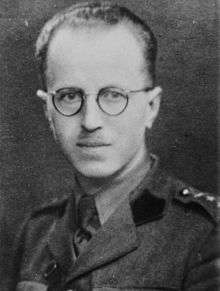
At the beginning of World War II, after September 17, 1939, Soviet bombers began dropping leaflets written in broken Polish over the city, announcing the imminent liberation "from the yoke of the lords" and other oppressors. On 18 September 1939 Navahrudak was occupied by the Red Army and, on 14 November 1939, incorporated into the Byelorussian SSR. Many residents of the city and region were repressed and exiled to other regions of the USSR, and the region was subjected to severe Sovietization.[42][43][44] In the administrative division of the new territories, the city was briefly the centre of Navahrudak Voblast until it moved to Baranavichy, and the name of voblast was renamed to Baranavichy Voblast and to the Navahrudak Raion (15 January 1940).
On 22 June 1941, the city was subjected to German bombing, the former Starostvo, formerly the Radziwill Palace, and shopping malls were destroyed, and on July 6, 1941, Germany invaded the Soviet Union, and on 4 July, Navahrudak was occupied by the Wehrmacht. Then, the Red Army was surrounded in the Novogrudok Cauldron. During the German occupation was followed by the active resistance to the Nazis. In mid-December 1943, the Polish resistance separated the Navahrudak district of the home Army from the Bialystok district. The headquarters of the home Army district was located in Lida. The Nazis killed about 4,500 Jews in the Navahrudak ghetto, Navahrudak and nearby villages during the Holocaust.[45] However, in mid-may 1943, the last remaining ghetto prisoners began to dig a 250-meter-long underground passage outside the ghetto, and five months later, on September 26, 1943, an escape was made through it.[46][47][48]. Всего через туннель бежали 232 человека[48] A total of 232 people escaped through the tunnel.[48] Some of the fleeing Jews joined the Bielski partisans, which actively fought against the Nazis on the territory of region[48].
During the German occupation, the city served as the administrative centre of Kreisgebiet Nowogrodek within the Generalbezirk Weißruthenien of Reichskommissariat Ostland. The local population was subjected to deportations for forced labour to Germany and executions.[27] In February-March 1944, by order of the German Commissar of the Navahrudak district Wilhelm Traube, former Lieutenant of the Polish army Barys Rahula formed the Belarusian Navahrudak mounted squadron to fight the partisans. In February 1944, the 65th guards battalion of the Belarusian police was formed in Navahrudak. In early July 1944, Barys Rahula curtailed the activities of the squadron.
During the German occupation in Navahrudak, the Nazarene nuns organized, at the request of the parents of Polish children, underground training in the Polish language and history. On 1 August 1943, the underground school ceased to exist after 11 nuns, the Martyrs of Nowogródek, including the main organizer of the school, were shot by the German occupiers on August 1, 1943.[49]
In the summer of 1944, units of the Navahrudak partisan district of the home Army took part in Operation Ostra Brama, fighting alongside the red army for the liberation of Vilna from the Nazis. On 8 July 1944, the Red Army recaptured Navahrudak after almost three years of German occupation. However, after the liberation of the entire Western Belarus from the Germans, the recent allies became enemies. Thus, on August 21, 1944, in the village of Surkontakh, the commander of the Navahrudak partisan district of the home Army, Lieutenant Colonel Maciej Kalenkiewicz, nicknamed "Kotvich" (1906-1944) from the Khubala detachment, was killed in a battle with tenfold superior units of the NKVD.[50] During the war, more than 45,000 people were killed in the city and the surrounding area, and over 60% of housing was destroyed.
Navahrudak had been an important Jewish centre. It was home to the Novardok yeshiva, led by Rabbi Yosef Yozel Horwitz, and was the hometown of Rabbi Yechiel Michel Epstein and the Harkavy Jewish family, including Yiddish lexicographer Alexander Harkavy. Before the war, the population was 20,000, approximately half Jewish and half Gentile. Meyer Meyerovitz and Meyer Abovitz were then the rabbis there. During a series of "actions" in 1941, the Germans killed all but 550 of the approximately 10,000 Jews. (The first mass murder of Navahrudak's Jews occurred in December 1941.) Those not killed were sent into slave labour.[15]
After the war, on this region did the organization "the black cat", which was aimed at the struggle against the Soviet regime, so in March 1948, the United group of troops of the organization "the black cat" with several units "bulbivtsiv" (total 200 men) attacked the Navahrudak to release the arrested members of his organization. The city was the base of The special Department of the MGB, which was engaged in the fight against anti-Soviet partisans.[51] The anti-Soviet partisan movement continued to exist until the early 1960s until it completely ceased to exist.[52][53][54]
After the war, the area remained part of the Byelorussian SSR, and most of the destroyed infrastructure was rapidly rebuilt. On 8 July 1954, following the disestablishment of the Baranavichy Voblast, the raion, along with Navahrudak, became part of the Hrodna Voblast, where it still is, now in Belarus.
Recent history
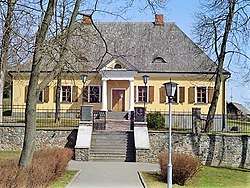
In 1997, Navahrudak and Navahrudaky district were merged into a single administrative unit. The city has links with the twin cities of Elbląg, Krynica Morska and Leymen.[55]
September 10, 2011 in honor of the 500th anniversary of the capital of the Grand Duchy of Lithuania Magdeburg law (freed from feudal duties, the power of voivodes, gave the right to create a magistrate-a self-government body, its seal and coat of arms — the image of the Archangel Michael) in the center of the city as a memory of the history and former greatness of the ancient city, a memorial sign was installed.[56]
According to the state program "Castles of Belarus", in 2012-15 it was planned to preserve the ruins of the Navahrudak castle with the restoration of its compositional structure and historical development, adaptation to modern social and cultural needs.[57]
It was concluded that it is impractical to restore buildings that store artifacts from the XIII to XVI centuries. The concept of "solid ruins" was approved, developed and reviewed at the Republican scientific and methodological meeting, the purpose of which was to reveal all seven towers of the Navahrudak castle, as well as the spinning walls. Thus the castle will be designated in the size of the XVI century.[57]
The metal structure and the brick prigruz will preserve the ruins of the Kostelnaya tower, stabilize it and complete the conservation of the object. Eventually, when scientists are convinced that the stabilization was successful, the prigruz will be removed.[57]
Will also partially restored the losses incurred by tower Shitovka. The tower will be covered with a roof, but will remain incomplete. It is planned to open a Museum, the Foundation of which will consist of exhibits that are now stored in the Navahrudak Museum of local history.[57]
The Church of the XIII century, the remains of which are now underground, will be shown with an application. At the level of about 50 centimeters, the masonry of the Palace will be opened. It is not planned to lower the entire porch. The ramparts that were around the perimeter will also be partially open. No buildings will be built on the porch itself.[57]
It is also planned to make a horizontal drainage to organize water drainage and stop the erosion of the soil of the southern slope.[57]
According to the resolution of the Council of Ministers of June 3, 2016 No. 437, Navahrudak castle was included in the list of 27 objects whose conservation costs (in terms of capital expenditures) can be financed from the national budget.[58]
Sites
- Navahrudak Castle, sometimes anachronistically called Mindaugas' Castle, was built in the 14th century, was burnt down by the Swedes in 1706, and remains in ruins.
- Construction of the Orthodox SS. Boris and Gleb Church, in Belarusian Gothic style, started in 1519, but was not completed until the 1630s; it was extensively repaired in the 19th century.
- The Roman Catholic Transfiguration Church (1712–23, includes surviving chapels of an older gothic building), where Adam Mickiewicz was baptised.
- Museum of Adam Mickiewicz at the poet's former home; there are also his statue and the "Mound of Immortality", created in his honour by the Polish administration in 1924–1931.
- Museum of Jewish Resistance. Also a red pebble path along the escape route during the heroic escape of ghetto inmates.
- Kastus Kachan Art Gallery
- Church of St. Michael, renovated in 1751 and 1831
- Trade rows at the central square
- Pre-war administration buildings, including the Nowogródek Voivodeship Office and the Voivode's House
Some members of the Harkavy family are buried at the old Jewish cemetery of Navahrudak.
 Ruins of the castle
Ruins of the castle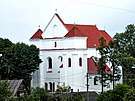
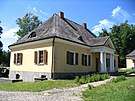 House of Adam Mickiewicz
House of Adam Mickiewicz- Church of Saint Michael Archangel
- Trade rows
- Pre-war Voivodeship Office

Climate
The Köppen Climate Classification subtype for this climate is "Dfb" (Warm Summer Continental Climate).[59]
Twin towns - sister cities
Navahrudak is twinned with:[60]





References
- "Структура райисполкома / Райисполком / Власть /". Новогрудский райисполком (in Russian). Archived from the original on 2016-03-05. Retrieved 2015-11-12.
- Численность населения на 1 января 2018 г. и среднегодовая численность населения за 2017 год по Республике Беларусь в разрезе областей, районов, городов и посёлков городского типа. // Национальный статистический комитет Республики Беларусь. — Мн., 2018.
- Гурэвіч
- Дучыц Л. У. Касцюм жыхароў Беларусі ХХ—ІІІ стст.(in Belarusian)
- Гуревич Ф. Д. [Дом боярина XII в. в древнерусском Новогрудке // Краткие сообщения Института археологии — Вып. 99. — 1964 — С. 97–102.
- Васильев Б. Г., Ёлшин Д. Д. Фресковая роспись «дома боярина» в окольном городе Новогрудка (по материалам коллекции фрагментов штукатурки) // Актуальные проблемы теории и истории искусства: сб. науч. статей. Вып. 7. / Под ред. С. В. Мальцевой, Е. Ю. Станюкович-Денисовой, А. В. Захаровой. — СПб.: Изд-во СПбГУ, 2017. С. 398–409.
- Гуревич Ф. Д. Древний Новогрудок. Л., 1981
- Н.П.Гайба. История Новогрудка Archived 2010-06-14 at the Wayback Machine
- "Oshchestvo Srednevekovoj Litvy". Viduramziu.lietuvos.net. Archived from the original on 2011-07-27. Retrieved 2013-02-18.
- Грыцкевіч 2007, p. 7.
- D. Antanavičius, D. Baronas etc. Mindaugo knyga: istorijos šaltiniai apie Lietuvos karalių. Vilnius, 2005. pp.63-93
- J. Geddie. The Russian Empire: Historical and Descriptive. P.102
- J. Phillips. The Medieval Expansion of Europe. p. 78
- Mindaugas, the King of Lithuania
- Carol Hoffman (2005). Shmuel Spector; Bracha Freundlich (eds.). "Pinkas Hakehillot Polin: Novogrudok". Encyclopedia of Jewish Communities. Jewishgen.org.
- Гайба М. Новагародак // Вялікае княства Літоўскае: Энцыклапедыя. У 2 т. / рэд. Г. П. Пашкоў і інш. — Мінск: БелЭн, 2007. — Т. 2 (К – Я) — С. З57 — ISBN 978-985-11-0394-8
- "Великое княжество Литовское". Государственная публичная научно-техническая библиотека СО РАН. Retrieved 2017-10-23.
- Грыцкевыч А. Гісторыя // Вялікае княства Літоўскае: Энцыклапедыя. У 2 т. / рэд. Г. П. Пашкоў і інш. — Мінск: БелЭн, 2007. — Т. 1 (А – К) — С. 7 — ISBN 978-985-11-0393-1
- Русина О. В. Міндовг // Енциклопедія історії України : у 10 т. / редкол.: В. А. Смолій (голова) та ін. ; Інститут історії України НАН України. — К. :Наук. думка, 2009. — Т. 6 (Ла — Мі) — С. 740 — ISBN 978-966-00-1028-1
- Maciej Stryjkowski (1985). Kronika polska, litewska, żmódzka i wszystkiéj Rusi Macieja Stryjkowskiego. Warsaw: Wydawnictwa Artystyczne i Filmowe. p. 572.
- Following the Tracks of a Myth Archived 2007-06-14 at the Wayback Machine Edvardas Gudavičius
- S.C. Rowell. Lithuania Ascending: A Pagan Empire within East-Central Europe, 1295-1345. Cambridge University Press, 1994. Page 149.
- Полное собрание русских летописей. Ипатьевская летопись. Москва, 1998. pp.880-881
- Słownik geograficzny Królestwa Polskiego i innych krajów słowiańskich, Tom VII, Warsaw, 1886, p. 256 (in Polish)
- "Навагрудак. Летапіс гісторыі". www.gaiba.narod.ru. Retrieved 2019-04-19.
- Mironowicz, A. (2011). Biskupstwo turowsko-pińskie w XI-XVI wieku. Trans Humana. p. 135. ISBN 978-83-61209-55-3.
- Monika Białkowska. "Historie z Nowogródka". Przewodnik Katolicki (in Polish). Retrieved 17 October 2019.
- Melchior Jakubowski, Maksymilian Sas, Filip Walczyna, Miasta wielu religii. Topografia sakralna ziem wschodnich dawnej Rzeczypospolitej, Muzeum Historii Polski, Warsaw 2016, p. 248 (in Polish)
- "Jubileusz 975 rocznicy powstania Nowogródka". Powiat Suwalski (in Polish). Retrieved 17 October 2019.
- "Nowogródek". Encyklopedia PWN (in Polish). Retrieved 17 October 2019.
- Wanda Rewieńska, Miasta i miasteczka magdeburskie w woj. wileńskim i nowogródzkim, Lida 1938, p. 11 (in Polish)
- Гайба, М. (2005). ВКЛ. энциклопедия. Т.2. Минск. p. 358. ISBN 9851103780.
- Tarasiuk (2007). Życie społeczno-kulturalne. Oświata. pp. 34–37.
- "JewishGen.org". Data.jewishgen.org. Retrieved 2013-02-18.
- Морозова С. "Наваградак — царкоўная сталіца Вялікага Княства Літоўскага (ХIV — XV стст.)". Archived from the original on 2016-03-08. // Гарады Беларусі ў кантэксце палітыкі, эканомікі, культуры: зборнік навук. артыкулаў / Гродз.дзярж. ун-т; рэдкалегія: І. П. Крэнь, І. В. Соркіна (адк. рэдактары) і інш. — Гродна: ГрДУ, 2007.
- А. В. Рощин. НЕМОГРАДАС — Летописный Новогородок
- К. Кузьмич. Какие тайны хранят развалины Новогрудского замка
- Ю. Л. Щапова. О резном бокале из Новогрудка / Средневековая Русь — М., 1976.- с. 214.
- Иван Саверченко, Дмитрий Санько. 150 пытанняў і адказаў з гісторыі Беларусі. Вильнюсс, 2002. страница 232
- Wyszczelski. Wyprawa wileńska. 2010. page 94
- Melchior Jakubowski, Maksymilian Sas, Filip Walczyna, Miasta wielu religii. Topografia sakralna ziem wschodnich dawnej Rzeczypospolitej, Muzeum Historii Polski, Warsaw 2016, p. 249 (in Polish)
- "Антисоветский блог: Массовая депортация жителей Западной Беларуси 1940 года". Антисоветский блог. 13 April 2017. Retrieved 2019-04-25.
- "Сталинские репрессий при «воссоединения» Беларуси в 1939г" (in Russian). Заметки о политике и о жизни. 2011-08-22. Retrieved 2019-04-25.
- ""Слушали. Постановили: расстрелять". Историк Игорь Кузнецов о советских репрессиях в Беларуси" (in Russian). TUT.BY. 2017-03-20. Retrieved 2019-04-25.
- "Туннель".
- "Побег из гетто". Archived from the original on 2017-06-18.
- И. А. Альтман. Холокост и еврейское сопротивление на оккупированной территории СССР
- «Памяць. Навагрудскi раён» 1996.
- "Tajne nauczanie polskie w czasie okupacji niemieckiej 1941–1944". Oświata... p. 67.
- "В августе 44-го. И после" (in Russian). warspot.ru. Retrieved 2019-04-28.
- Матох Василий. Лесные братья // Информационно-аналитический еженедельник «БелГазета» (www.belgazeta.by) 17.04.2006. — № 15 (534); на сайте «Историческая правда» (www.istpravda.ru) 04.12.2012 (с фотоматериалами). Archived 2013-06-19 at the Wayback Machine
- Ёрш Сяргей, Лескець Сяргей (2003). "Драгічіншчіна". Была вайна…. Менск: Беларускі Рэзыстанс. p. 12.
- Ёрш Сяргей. Салідарнасць Камандзір беларускіх «лясных братоў» (фота друкуюцца ўпершыню) // Сайт газеты «Салідарнасць» (www.gazetaby.com) 04.11.2007.
- Беларускі пасляваенны антысавецкі супраціў 1944−1957 гг. on YouTube
- "История Новогрудка | НОВОГРУДОК.BY" (in Russian). Retrieved 2019-04-25.
- В Новогрудке открыли памятный знак к 500-летию получения городом магдебургского права (установлен слева от здания исполнительного комитета Новогрудского района)
- РЭКАНСТРУКЦЫЯ ЗАМКА ПРАЦЯГВАЕЦЦА // Новае жыццё
- Постановление Совета Министров от 03.06.2016 № 437 О некоторых вопросах обеспечения сохранности историко-культурных ценностей
- Climate Summary for Navahrudak
- "Города-побратимы". novogrudok.gov.by (in Russian). Navahrudak. Retrieved 2020-01-13.
Bibliography
- Грыцкевіч А. Гісторыя // Вялікае княства Літоўскае: Энцыклапедыя. У 2 т. / рэд. Г. П. Пашкоў і інш. — Мінск: БелЭн, 2007. — Т. 1 (А – К). — С. 7–33. — ISBN 978-985-11-0393-1.
- Гайба М. Новагародак // Вялікае княства Літоўскае: Энцыклапедыя. У 2 т. / рэд. Г. П. Пашкоў і інш. — Мінск: БелЭн, 2007. — Т. 2 (К – Я). — С. З57–359. — ISBN 978-985-11-0394-8.
- Малевская М. В. Амфора с надписью из Новогрудка // Советская археология. 1962. No. 4.
- Беларуская энцыклапедыя: У 18 т. Т. 11: Мугір — Паліклініка / Рэдкал.: Г.П. Пашкоў і інш. — Мн.: БелЭн, 2000. — 560 с.: іл. ISBN 985-11-0188-5
- Гайба М. Навагрудак: гады і падзеі. — Навагрудак, 1996.
- Гурэвіч Ф. Летапісны Новгородок (Старажытнарускі Наваградак). — Санкт-Пецярбург — Наваградак: Агентство «РДК-принт», 2003. — 324 с.
- Цітоў А. Геральдыка Беларускіх местаў / Маст. А. Бажэнаў. — Менск: «Полымя», 1998. — 287 с.: іл. ISBN 985-07-0131-5.
- Энцыклапедыя гісторыі Беларусі. У 6 т. Т. 5: М — Пуд / Беларус. Энцыкл.; Рэдкал.: Г. П. Пашкоў (галоўны рэд.) і інш.; Маст. Э. Э. Жакевіч. — Менск: БелЭн, 1999. — 592 с.: іл. ISBN 985-11-0141-9.
- Zaprudnik J. Historical dictionary of Belarus. — Lamham. — London: Scarecrow Press, 1998. — 338 p. ISBN 0-8108-3449-9.
- Grędzik-Radziak A. Oświata i szkolnictwo polskie na ziemiach północno-wschodnich II Rzeczypospolitej i współczesnej Białorusi 1939–2001. — Toruń: Europejskie Centrum Edukacyjne, 2007. — 441 с. — ISBN 978-83-60738-09-2
- Słownik geograficzny Królestwa Polskiego i innych krajów słowiańskich. Tom VII: Netrebka — Perepiat. — Warszawa, 1886.
- Памяць: Гісторыка-дакументальная хроніка Навагрудскага раёна. — Мн.: Беларусь, 1996.
External links
| Wikimedia Commons has media related to Navahrudak. |
